I am working on an audio project that needs to drive 16 balanced xlr cable runs with stereo differential audio. For this purpose I am using the following op-amp circuit to produce a low impedance differential output:
In this circuit R20 functions as a current limiting resistor, and effectively sets the output impedance at 75 ohms, while C32 and R24 decouple the audio signal from the DC bias.
In my application I am generating a stereo test signal and sending it to all available outputs (alternating left and right for even and odd), so I just need a way to safely buffer the output a bunch of times in such a way that the outputs can't interact with one another.
My question is whether I can safely drive multiple lines off the same op-amp by simply attaching multiples of the R20, C23, R24 current-limiting + decoupling circuit to the same op-amp outputs. Theoretically with an ideal op-amp circuit this should work fine, since the op-amp will hold the voltage constant at it's output, and the output resistors will limit current preventing voltage drop, but I am wondering if this can lead to problems with noise, or other interaction between the output lines when put into physical practice. Furthermore, seeing as I'm planning to drive up to 16 lines, is there a way I can calculate a max channel cutoff for when I should break this method out to multiple op-amps?
This is meant to be a piece of test equipment, so having it be reliably low noise is important, but being able to have a single op-amp package rather than 16 of them would be a big reduction in cost and board space, so it's worth exploring.
Thanks!
